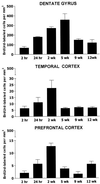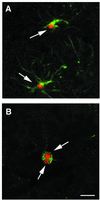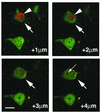Adult-generated hippocampal and neocortical neurons in macaques have a transient existence
- PMID: 11526209
- PMCID: PMC58573
- DOI: 10.1073/pnas.181354698
Adult-generated hippocampal and neocortical neurons in macaques have a transient existence
Abstract
Previously we reported that new neurons are added to the hippocampus and neocortex of adult macaque monkeys. Here we compare the production and survival of adult-generated neurons and glia in the dentate gyrus, prefrontal cortex, and inferior temporal cortex. Twelve adult macaques were injected with the thymidine analogue BrdUrd, and the phenotypes of labeled cells were examined after 2 h, 24 h, 2 wk, 5 wk, 9 wk, and 12 wk by using the following immunocytochemical markers: for immature and mature neurons, class III beta-tubulin (TuJ1); for mature neurons, neuronal nuclei; for astrocytes, glial fibrillary acidic protein; and for oligodendrocytes, 2',3'-cyclic nucleotide 3' phosphodiesterase. We found that the dentate gyrus had many more BrdUrd-labeled cells than either neocortical area. Furthermore, a greater percentage of BrdUrd-labeled cells expressed a neuronal marker in the dentate gyrus than in either neocortical area. The number of new cells in all three areas declined by 9 wk after BrdUrd labeling, suggesting that some of the new cells have a transient existence. BrdUrd-labeled cells also were found in the subventricular zone and in the white matter between the lateral ventricle and neocortex; some of the latter cells were double-labeled for BrdUrd and TuJ1. Adult neocortical neurogenesis is not restricted to primates. Five adult rats were injected with BrdUrd, and after a 3-wk survival time, there were cells double-labeled for BrdUrd and either TuJ1 or neuronal nuclei in the anterior neocortex as well as the dentate gyrus.
Figures








References
-
- Hastings N B, Tanapat P, Gould E. Neuroscientist. 2000;6:315–325.
-
- Goldman S A. J Neurobiol. 1998;36:267–286. - PubMed
-
- Privat A, Leblond C P. J Comp Neurol. 1972;146:277–302. - PubMed
-
- Lopez-Garcia C, Molowny A, Garcia-Verdugo J M, Ferrer I. Brain Res. 1988;471:167–174. - PubMed
-
- Altman J. Anat Rec. 1963;145:573–591. - PubMed
Publication types
MeSH terms
Substances
Grants and funding
LinkOut - more resources
Full Text Sources
Other Literature Sources

